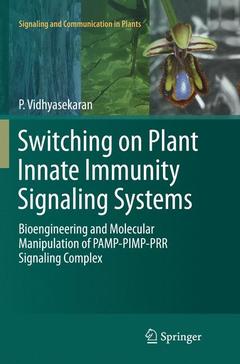1. Introduction
1.1 Plant Innate Immunity is a Sleeping Giant to Fight against Pathogens
1.2 Potential Signals to Switch on Plant Immune System
1.3 Pathogens Possess Weapons to Switch-off Plant Immune Systems
1.4 Bioengineering and Molecular Manipulation Technologies to Switch on the Sleeping Quiescent Plant Immune System to Win the War against Pathogens
1.5 Switching on Plant Innate Immunity Using PAMP-PIMP-PRR-Transcription Factor is the Most Potential Biotechnological Approach for Management of Crop Diseases
2. Role of Plant Immune Signals and Signaling Systems in Plant Pathogenesis
2.1 Susceptibility and Disease Resistance are Two Sides of the Same Coin Modulated by Plant Immune &
nbsp; System Signals and Signaling Systems
2.2 Signals and Signaling Systems Involved in Triggering Immune Responses
2.3 Reduced Activity of PAMPs May Facilitate the Virulent Pathogens to Cause Disease
2.4 Pathogen-Secreted Effectors Suppress PAMP-Triggered Plant Immune Responses
2.5 Host Plants May Manipulate the Defense Signaling Systems to Suppress the Disease Development
2.6 Specificity of Plant Hormone Signaling Systems in Conferring Resistance Against Various Pathogens
2.7 Plant Hormone Signaling Systems May Also Induce Susceptibility Against Pathogens
2.8 Pathogens
May Hijack Specific Signaling Pathways to Cause Disease
2.9 Pathogens May Suppress Specific Signaling System to Promote Disease Development
3. Switching on Plant Immune Signaling Systems Using Microbe-Associated Molecular Patterns
3.1 PAMP-Triggered Immunity
3.2 Harpin PAMPs as Molecular Tools to Manipulate PAMP-Triggered Immunity
3.3 Engineering Harpin Gene to Develop Disease Resistant Plants
3.4 Molecular Manipulation of Plant Innate Immune Signaling Systems Using Flagellin
3.5 Molecular Manipulation of Plant Immune Systems Using the PAMP Elicitins
3.6 Manipulation of Plant Immune System Using Chitosan
3.7 Manipulation of Plant Immune System Using Cerebrosides
3.8 Manipulation of Plant Immune System Using CfHNNI1 Elicitor
3.9 Bioengineering FsphDNase
Elicitor gene to Trigger Plant Immune Responses against Wide Range of Pathogens
3.10 Engineering the Elicitor-encoding pemG1 Gene for Crop Disease Management
3.11 Manipulation of Plant Immune System Using the MAMP Rhamnolipids
3.12 Manipulation of Plant Immune System Using the Proteinaceous Elicitor Sm1 Derived from Trichoderma virens
3.13 Manipulation of Plant Immune Responses Using Yeast-Derived Elicitors\
4. Switching on Plant Immune Signaling Systems Using Pathogen-Induced Molecular Patterns/Host-
Associated Molecular Patterns
4.1 Pathogen-Induced Molecular Patterns (PIMPs)/Host-associated Molecular Patterns (HAMPs)
4.2 Oligogalacturonides Switch on Plant Innate Immunity
4.3 OGAs with Different Degrees of Polymerization Differ in Triggering Defense Responses
4.4 Degree of Methyl Esterification of OGAs Modulates the Elicitor Activity of OGAs
4.5 Ability of OGAs to Trigger Defense Responses May Depend on their Level of Acetylation
4.6 Engineering Pectin Methyl Esterase Genes to Develop Disease Resistant Plants
4.7 Bioengineering Pectin Methyl Esterase Inhibitor Protein for Plant Disease Management
4.8 Engineering PG Gene to Develop Disease Resistant Plants
4.9 Engineering PGIP gene to Develop Disease-Resistant Plants
4.10 Manipulation of Oligogalacturonides by Salicylic Acid (SA) Analog to Induce Resistance against Pathogens
4.11 Switching on Plant Imm
une Signaling Systems Using Plant Elicitor Peptides (Peps) for Disease
4.12 Switching on Plant Immune Signaling Systems Using Systemin for Disease Management
5. Switching on Plant Immune Signaling Systems Using Pattern Recognition Receptor Complex
5.1 Pattern Recognition Receptors (PRRs)
5.2 Importance of PRRs in Triggering Defense Responses Against Pathogens
5.3 Engineering PRRs for Disease Management
5.4 PRR-Interacting Protein Complexes
5.5 Engineering PRR-Interacting Protein Complexes for Crop Disease Management
6. Molecular Manipulation of Transcription Factors, the Master Regulators of PAMP-Triggered Signaling Systems
6.1 Transcription Factor
s as ‘Master Switches’ Regulating Expression of Defense Genes in Plant Immune Signaling Systems
6.2 PAMPs and PIMPs/HAMPs Trigger Expression of Transcription Factors
6.3 Role of Transcription Factors in Regulation of Ca2+ Signaling System
6.4 ROS-Regulated Expression of Transcription Factors
6.5 MAPKs-Modulated Phosphorylation of Transcription Factors in Activation of Plant Immune Responses
6.6 Transcription Factors Regulating Salicylate Signaling in Plant Innate Immune System
6.7 Transcription Factors Regulating Jasmonate Signaling System in Plant Innate Immunity
6.8 Transcription Factors Regulating Ethylene Signaling System in Plant Innate Immunity
6.9 Transcription Factors May Trigger “Priming” of Defense Responses
6.10 Bioengineering WRKY Transcription Factors for Rice Disease Management
6.11 Bioengineering WRKY Transcription Factors for Wheat Disease Management
6.12 Bioengineering WRKY Transcription Factors for Tobacco Disease Management
6.13 Bioengineering WRKY Transcription Factors for Management of Grapevine Diseases6.14 Search for Arabidopsis Transcription Factor Genes for Using as Tools for Engineering Disease- Resistant Plants
6.15 Manipulation of OsWRKY45 Transcription Factor–dependent Priming Process Using Benzothiadiazole Compounds for Rice disease Management
6.16 Manipulation of Priming of WRKY Transcription Factors Using BABA for Crop Disease Management
6.17 Manipulation of WRKY Gene Expression Using Ergosterol for Disease Ma
nagement
6.18 Manipulation of MYB Transcription Factors for Disease Management
6.19 Molecular Manipulation of MYC2 Transcription Factor Using Rhizobacteria to Trigger Priming and ISR for Disease Management
6.20 Molecular Manipulation of bZIP Transcription Factors for Crop Disease Management
6.21 Manipulation of EREBP Transcription Factors for Crop Disease Management
6.22 Manipulation of NAC Transcription Factors for Crop Disease Management
6.23 Engineering NtWIF Transcription Factor Gene for Crop Disease Management
6.24 Engineering AT-Hook Motif-Containing Transcription Factor Gene (CaATL1) for Crop Disease Management




